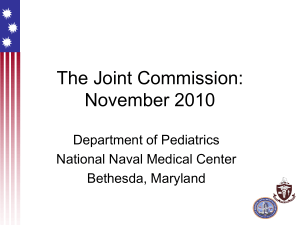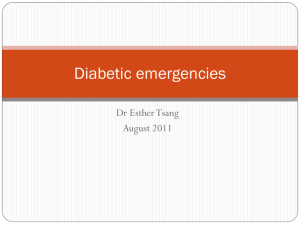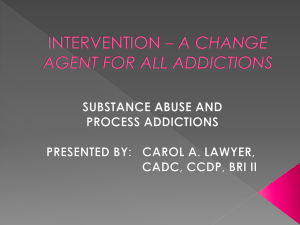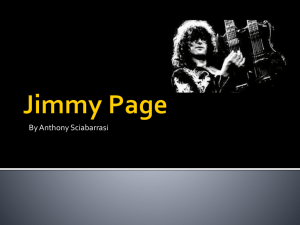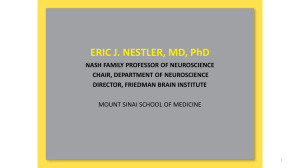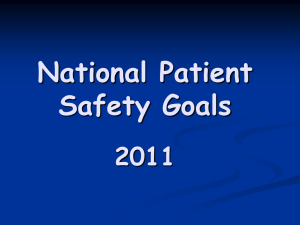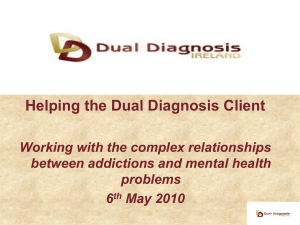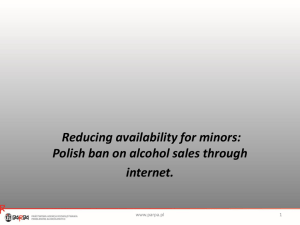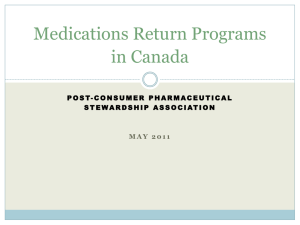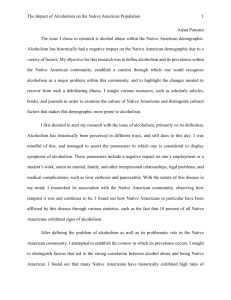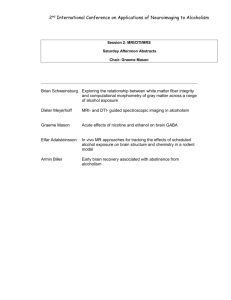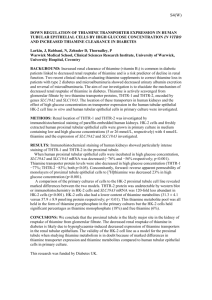Medical Treatment Alcoholism
advertisement
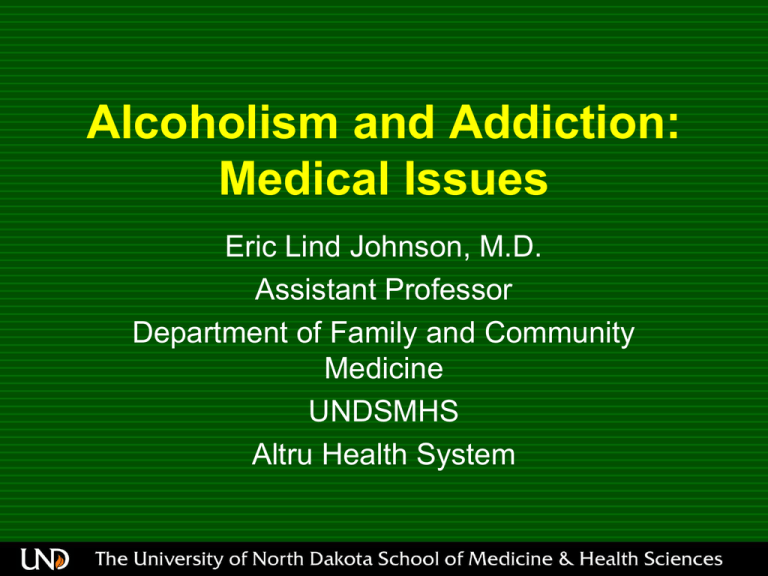
Alcoholism and Addiction: Medical Issues Eric Lind Johnson, M.D. Assistant Professor Department of Family and Community Medicine UNDSMHS Altru Health System Objectives • Review basic physiology, signs, and symptoms related to alcoholism • Review common medical complications and their treatment in alcoholism • Understand resources available for treatment of alcoholism Alcohol/Ethanol • Mechanisms of Toxicity – CNS depressant – Teratogen – Carcinogen Basic Alcohol Physiology • 25% enters the bloodstream from the stomach, 75% from the intestine • 90% to 98% is removed in the liver, and the remainder is excreted by the kidneys, lungs, and skin. • 70-kg man can metabolize 5 to 10 g ethanol per hour (average drink contains 12 to 15 g ethanol)-alcohol dehydrogenase 90% Blood Ethanol Levels Blood Ethanol Level Sporadic Drinkers Chronic Drinkers 50-100 Euphoria, gregariousness, incoordination Minimal or no effect 100-200 Slurred speech, ataxia, labile mood, drowsiness, nausea Sobriety or incoordination Euphoria 200-300 Lethargy, combativeness Stupor, incoherent speech, vomiting Mild emotional and motor changes 300-400 Coma Drowsiness >500 Death Lethargy, stupor, coma adapted from Goldman: Cecil Textbook of Medicine, 21st ed., Copyright © 2000 W. B. Saunders Company Medical Model of Alcoholism • Signs: • Heavy recurrent alcohol use and/or intoxication • Other drug use or unexpected drug responses or interactions • Trauma • Absenteeism, presenteeism • Personal neglect Medical Model of Alcoholism • • • • • • • • Symptoms: Nausea, vomiting Unexplained diaphoresis Tachycardia Seizures, hallucinations Withdrawal, tremors, blackouts Depression, anxiety, sleep disturbance Erectile dysfunction in men Medical Model of Alcoholism • Etiology: Familial-Heritability estimated at 40-60% • Less in certain populations (i.e. southeast Asians) • Possibly more damaging for women Signs/Symptoms of Suspected Alcoholic Patient in a Clinic Setting • • • • • • • • • Fatigue Absenteeism/Presenteeism Depression/Anxiety/Psychosocial Issues (Family History) Obesity Hypertension Hepatomegaly Gastrointestinal Complaints None Initial Laboratory Evaluation of Suspected Alcoholic Patient • • • • Blood alcohol (drug screen) LFT’s (GGTP) elevated MCV elevated triglycerides These may be totally unrevealing…. Medical Complications • GI tract/Liver: Fatty liver, hepatitis, cirrhosis, esophagitis, gastritis pancreatitis, cancers • Nervous system: Brain: Hepatic encephalopathy, Wernicke-Korsakoff syndrome(thiamine deficiency), cerebellar degeneration, central pontine myelinolysis, dementia Medical Complications • Nutrition: Deficiencies of Vitamins: Folate, thiamine, pyridoxine, niacin, riboflavin Minerals: Magnesium, zinc, calcium Protein • Metabolites and electrolytes Hypoglycemia, ketoacidosis, hyperlipidemia, hyperuricemia, hypomagnesemia, hypophosphatemia Medical Complications • Neuromuscular: Neuropathy, myopathy • Cardiovascular: Arrhythmia, cardiomyopathy, Hypertension • Bone marrow: Macrocytosis, anemia, thrombocytopenia, leukopenia Medical Complications • Endocrine: Pseudo-Cushing's syndrome, testicular atrophy, amenorrhea, DM?, Osteopenia/osteoporosis • Other cancers? (i.e., breast) • Traumatic injury • Fetal alcohol syndrome Fetal Alcohol Syndrome • 1 to 3 births per 1,000 world wide • 1968 first association by French researchers at the University of Nantes • Early 1970’s FAS as condition – University of Washington • 4,000-12,000 infants per year in US Fetal Alcohol Syndrome • NO use of alcohol in pregnancy is safe • Microcephaly, distinctive facial features, developmental delay, behavioral disorders. • Occurs in about 6 percent of children of alcoholic women • Fetal alcohol effect-more common, more subtle Detoxification and Withdrawal Syndromes Alcohol Overdose • • • • • ABC’s Oxygen, assisted ventilations Intubate IV, infuse fluid to support perfusion Lavage if within 2 hours Alcohol Overdose – Dextrose, Oxygen, Narcan, Thiamine – Glucose, thiamine (50-100mg) – Narcan may reduce respiratory depression but not CNS depression (? Use) • Dialysis - removes 280mg/minute Treatment of Initial Withdrawal and Agitation Benzodiazepines: • Diazepam • Lorazepam • Chlordiazepoxide Neuroleptics: • Phenothiazines may be used as adjunct to benzodiazepines Detoxification • Severe Withdrawal (Delirium Tremens) occurs about 3-7%. High mortality. May occur days after last use. BP, pulse good indicators. • Long acting benzodiazepines (Librium), IV fluids, Thiamine, Multivitamin all started on admission. Co-Morbid Conditions • Medical • Psychiatric: Depression, Anxiety, or Bipolar Disorder common • SSRI’s have the most data in Treatment of Depression in this population Medical Treatment of Alcoholism Treatment of Alcoholism • Traditional Inpatient/Outpatient • 12 step: AA(oldest, common), Specialty groups • Medication • Usually a combination of all 3 Medications for Alcohol Dependence • Three oral medications (approved) -Naltrexone -Acamprosate -Disulfiram • One injectable medication (approved) -Extended-release injectable naltrexone Medications for Alcohol Dependence • Topiramate (off label) Also used for bipolar disorder • Future directions -Endocannibinoid receptor blockers -Nicotinic receptor agonist/antagonist • Combining medications uncertain benefit Medication Management • Consider in those failing typical psychosocial approaches • Used typically in those whose program includes abstinence from alcohol • Combining Medications and Behavioral Interventions (COMBINE) clinical trial -Benefit medications/counseling combined • Medications usually prescribed 6 to 12 months • Twice weekly brief counseling efficacious Naltrexone • Blocks opioid receptors • Oral or injection • 28% relapse rate vs 46% with placebo Acamprosate • • • • GABA and glutamate receptors 17 clinical trials 36% abstinent vs 23% on placebo Better results in European trials (more dependent patients?) • Can’t use in liver disease Disulfuram • Interferes with alcohol metabolism, increases aldehyde concentrations results in flushing, nausea, vomiting • Poor compliance is typical • Maybe better in short-term high-risk situations Topiramate • GABA, glutamate receptors (?) • Some efficacy in those not abstinent at start of medication • Used for other psych disorders Alcohol Treatment • • • • Typically a cognitive-behavioral model Motivational Interviewing Stages of Change Often incorporate some “12 step” concepts “12 Step” Groups • • • • • AA oldest, founded 1935 Founders were acquainted with Carl Jung Mentoring (“sponsor”) encouraged Not “group” therapy Members are encouraged to seek outside help, physician, clergy, psych, etc. • No cost (voluntary donations) Outcome Predictors • • • • • • • Severity of addiction or withdrawal Psychiatric Co-morbidity Substance Related Problems Multiple Substance Abuse Length of Treatment Genetic Socio-Economic Psychiatric Clinics N Am 26 (2003) 381–409 Summary • Effective alcohol screening and guidelines • Medications appropriate for some • Medications not a substitute for traditional psychosocial interventions/resources • Combination of above likely more effective
